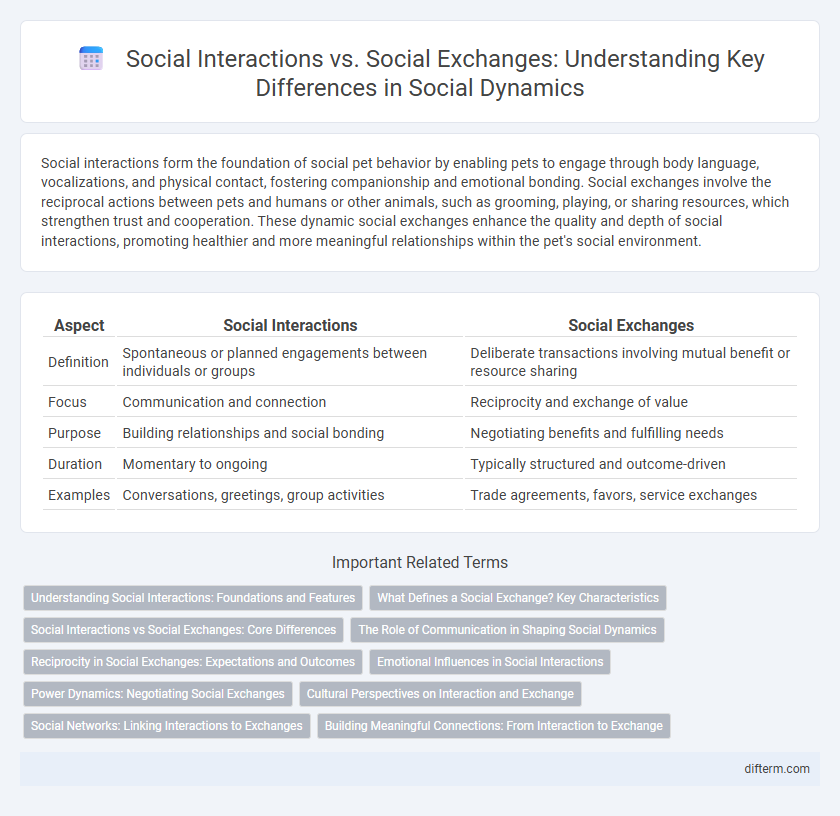Social interactions form the foundation of social pet behavior by enabling pets to engage through body language, vocalizations, and physical contact, fostering companionship and emotional bonding. Social exchanges involve the reciprocal actions between pets and humans or other animals, such as grooming, playing, or sharing resources, which strengthen trust and cooperation. These dynamic social exchanges enhance the quality and depth of social interactions, promoting healthier and more meaningful relationships within the pet's social environment.
Table of Comparison
| Aspect | Social Interactions | Social Exchanges |
|---|---|---|
| Definition | Spontaneous or planned engagements between individuals or groups | Deliberate transactions involving mutual benefit or resource sharing |
| Focus | Communication and connection | Reciprocity and exchange of value |
| Purpose | Building relationships and social bonding | Negotiating benefits and fulfilling needs |
| Duration | Momentary to ongoing | Typically structured and outcome-driven |
| Examples | Conversations, greetings, group activities | Trade agreements, favors, service exchanges |
Understanding Social Interactions: Foundations and Features
Social interactions encompass a broad range of verbal and nonverbal behaviors occurring between individuals within various contexts, forming the foundation of human relationships. Social exchanges specifically refer to the reciprocal process where resources, emotions, or information are traded, emphasizing mutual benefit and interdependence. Understanding these dynamics reveals how social norms, trust, and communication patterns shape effective and meaningful connections in communities and organizations.
What Defines a Social Exchange? Key Characteristics
A social exchange is defined by reciprocal interactions where individuals provide resources, support, or benefits with the expectation of receiving something in return, fostering mutual trust and cooperation. Key characteristics include the presence of valued resources, mutual dependence, and negotiated relationships that balance costs and rewards. Unlike general social interactions, social exchanges emphasize deliberate, outcome-oriented transactions grounded in social norms and exchange theory.
Social Interactions vs Social Exchanges: Core Differences
Social interactions encompass any form of communication or action between individuals, focusing on mutual influence and relationship building without necessarily involving tangible rewards. Social exchanges specifically refer to transactions where individuals seek to gain benefits, emphasizing reciprocity and cost-benefit analysis within these interactions. The core difference lies in the intent and outcome: social interactions prioritize connection and shared experiences, while social exchanges prioritize exchange of resources and mutual advantage.
The Role of Communication in Shaping Social Dynamics
Communication acts as the cornerstone in shaping social dynamics by facilitating the exchange of information, emotions, and meanings that define social interactions. Social interactions rely on verbal and nonverbal communication cues to establish trust, build relationships, and coordinate group behaviors. Effective communication enhances social exchanges by creating shared understanding and reinforcing social bonds within communities.
Reciprocity in Social Exchanges: Expectations and Outcomes
Reciprocity in social exchanges involves mutual expectations where each participant anticipates a return of benefits or favors, fostering trust and cooperation. These exchanges differ from general social interactions by emphasizing balanced give-and-take, which strengthens social bonds and promotes long-term relationships. Failure to meet reciprocal expectations can lead to social tension or weakened ties, highlighting the critical role reciprocity plays in maintaining social exchange dynamics.
Emotional Influences in Social Interactions
Emotional influences in social interactions significantly shape individuals' behavior, fostering empathy, trust, and rapport essential for meaningful connections. Unlike social exchanges centered on the transactional transfer of resources, social interactions driven by emotions emphasize shared feelings and mutual understanding. Positive emotional experiences enhance cooperation and strengthen relational bonds, facilitating deeper social integration and well-being.
Power Dynamics: Negotiating Social Exchanges
Power dynamics play a crucial role in negotiating social exchanges, as individuals constantly assess the balance of influence and control within interactions. Social exchanges are shaped by the perceived costs and benefits, where power disparities can affect decision-making and resource distribution. Understanding these dynamics enhances the prediction of behavior patterns and the stability of social relationships.
Cultural Perspectives on Interaction and Exchange
Social interactions, shaped by cultural norms and values, influence the way individuals communicate and form relationships within diverse communities. Social exchanges go beyond mere interactions by incorporating reciprocal behaviors and expectations that are culturally defined, affecting trust and cooperation. Understanding these cultural perspectives is essential for fostering effective communication and meaningful connections across different social groups.
Social Networks: Linking Interactions to Exchanges
Social networks serve as dynamic platforms where social interactions evolve into meaningful social exchanges, facilitating the transfer of resources, information, and support among individuals. These networks enable the formation of intricate relational patterns that influence behavior, trust, and reciprocity within communities. By linking interactions to exchanges, social networks amplify the value of connections, driving social capital and fostering cooperation across diverse groups.
Building Meaningful Connections: From Interaction to Exchange
Building meaningful connections requires moving beyond superficial social interactions to deeper social exchanges that involve trust, empathy, and mutual understanding. Social exchanges foster lasting relationships by promoting reciprocity and shared experiences, which enrich personal and professional bonds. Emphasizing quality over quantity in these exchanges enhances emotional support and cultivates a sense of belonging within communities.
social interactions vs social exchanges Infographic

 difterm.com
difterm.com